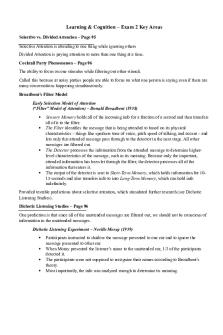CHE 101 test 2 notes - Exam 2 summary sheet/guide - General Chemistry Lecture PDF

| Title | CHE 101 test 2 notes - Exam 2 summary sheet/guide - General Chemistry Lecture |
|---|---|
| Course | General Chemistry Lecture |
| Institution | University at Buffalo |
| Pages | 7 |
| File Size | 151.6 KB |
| File Type | |
| Total Downloads | 49 |
| Total Views | 141 |
Summary
Exam 2 summary sheet/guide...
Description
CHE$101$ Chapter$4:$Reactions$in$Aqueous$Solution$ $ Aqueous'Solution'Properties' 1. Solution'(Soln):$a$homogenous$mixture$of$two$or$more$substances$ -Includes$two$components:$ • Solvent:$Substance$in$greater$quantity$ • Solute:$Substance$in$smaller$quantity$ $ Soln=$solute$+$solvent$ 2. Aqueous'solution'(aq):$dissolved$in$water$ • Solvent:$Water$ • Solute:$ionic$compounds$(metal$&$nonmetal),$molecular$compounds$ -When$ionic$compounds$dissolve$in$water:$ a. Compounds$dissociates$into$positive$and$negative$ions$ b. Ions$are$surrounded$by$water$molecules$(Solvation)$ Ø This$process$is$called$dissociation$ -Resulting$aqueous$solution$contain$ion$conducts$electricity$(electrolytes)$ *More$ions,$more$conductive$it$gets$(more$electricity)$ 3. Electrolyte:$substance$that$forms$ions$when$dissolved$in$water$ • Strong$Electrolytes:$Completely$as$ions,$high$conductivity$ o Ionic$Compounds$(NaCl)$ o Strong$Acids,$Strong$bases$ NaCl$(aq)$->$Na+$(aq)$+$Cl-$(aq)$$$$2$ions$ Ca3(PO4)2$->$2Ca2+$(aq)$+$2PO43-$(aq)$$$5ions$ • Weak$Electrolytes:$Small$fraction$in$the$form$of$ions,$low$conductivity$ o Weak$acid,$weak$bases$ 4. Nonelectrolytes:'does$not$form$ions$when$dissolved,$no$conductivity$ • Molecular$Compounds$(C12H22O11)$ $ Example:$The$diagram$below$represent$an$aqueous$solution$of$one$of$the$following$ compounds:$MgCl2,$KCl$or$K2SO4.$Which$solution$does$it$best$represent?$ -K2SO4$ $ Acids'and'Bases:' 1. Acids:$Substance$that$produce$H+'ion$(proton)$ $ HCl(aq)$->$H+(aq)$+$Cl-(aq)$ Ø Can$form$different$number$of$protons$ -H2SO4$2$H+$(diprotic)$ -H3PO4$3$H+$(tripotiic)$ -HC2H3O2$1$H+$$ Not$all$the$H$atoms$in$a$moleculare$are$acidic$ -In$organic$acids$(finish'copying'notes'here)' 2. Strong'Acids:$Ionized$completely,$strong$electrolyte$ HNO3$(aq)$->$H+$(aq)$+$NO3-$(aq)$ $
Memorize'list:' Only'Seven'strong'acids:' 1.$Hydochloric$(HCl)$ 2.$Hydobromic$$(HBr)$ 3.$Hydroiodic$(HI)$ 4.$Nitric$(HNO3)$ 5.$Sulfuric$(H2SO4)$ 6.$Chloric$(HClO3)$ 7.$Perchloric$$(HClO4)$ 3. Strong'Bases:$ionized$completely,$strong$electrolyte$ Ca(OH)2$(aq)$->$Ca2+$(Aq)$+$2OH-$(aq)$ 4. Weak'Acids:$Partially$ionized,$weak$electrolyte$ H2S$(aq)$$2H+$(aq)$+$S2-$(aq)$ Ø HF$ 5. Weak'Bases:$Ionized,$weak$electrolyte$ Ø Such$as$NH3$ Ø NH3$(aq)$+$H2O$(l)$$NH4+$(aq)$+$OH-$(aq)$ Example:' $Indicate$the$type$of$electrolyte$for$SrF2$ • Strong$(its$an$ionic$compound;$metal$and$nonmetal)$ Indicate$the$type$of$electrolyte$for$NH4Br$ • Strong$(it’s$a$diatomic$ion;$ammonium)$ Which$chemical$will$conduct$more?$ • SrF2$ ' Types'of'Reactions:' Many$reactions$have$characteristics$in$common$ • Combination$ • Decomposition$ • Combustion$ • *COPY$REST$from$slides$ $ How'to'Predict'Phases:' 1. Metals:$solids$ 2. Diatomic:$gases$ 3. Acids:$aq$ 4. Solutions:$aq$ 5. Water:$liquid$$ a. Unless$specified$ $ Solubility'of'Ionic'Compounds' Solubility:$The$amount$of$electrolyte$(Strong$or$weak)$dissolved$in$a$given$amount$ solvent$at$a$certain$temperature$ *Soluble:$dissolves$in$water$ $
Always'soluble'ions:' Group$1$(alkali$metals)$salts$ NH4+$ NO3-$ CH3COO$ $ Example:$Classify$the$ionic$compounds$as$soluble$or$insoluble$in$water$(look$at$ table$4.1)$ NaCO3:$soluble$ SrSO4:$insoluble$ NaOH:$soluble$ Pb3(PO4)2:$Insoluble$ ' Double'Replacement'Reactions$ Double$Replacement:$Cations$and$anions$exchange$partner$when$two$ionic$ compounds$interact$(exchange$reaction)$ • Also$called$Methasis$rxn$ o AX$+$BY$->$AY$+$BX$ o AgNO3$(aq)$+$KCl$(aq)$->$AgCl$(s)$+$KNO3$(aq)$ o There$are$two$types$of…(finish'copying'notes'here)$ Precipitation$reaction:$when$one$of$the$products$formed$is$an$insoluble$solid$ • Precipitate:$insoluble$solid$formed$by$a$reaction$in$solution$ o Looks$cloudly$ o BaCl2$(aq)$+$K2SO4$(aq)$->$Ba$(charge$from$reaction$side)$ 2+$$-1$ $ $ $$$$$$$$$2+$ BaCl2$(Aq)$+$K2SO4$(aq)$->$BaSO4$(s)$$+$2KCl$(aq)$ $ $ $ $ ^$Precipitate$ 4.7$Charge?$ $$ Neutralization$reaction:$Reaction$between$an$acid$and$a$base$ -Produces$salt$and$water$ $ Acid$(aq)$+$Base$(aq)$->$H2O$(l)$sometimes$+$salt$(always)$ Salt:$an$ionic$compound$whose$cation$comes$from$a$base,$and$its$anion$comes$from$ an$aicd$ $ HCl$(aq)$+$$Ca(OH)2$(aq)$->$H+OH-$ $ HCl$(aq)$+$Ca(OH)2$(aq)$->$H2O$(l)$+$CaCl2$(aq)$ Gas$Forming$Neutralization$Reaction:$Sometimes$the$product$decomposes$to$give$a$ gaseous$product$ • An$unstable$compound$is$produced$ • This$compound$immediately$decomposes$into$new$chemicals$ o H2CO3$(aq)$->$CO2$(g)$+$H2O$(l)$ K2CO3$(aq)$+$HCl$(aq)$->$$K+Cl-$$+$H+CO32-$ K2CO3$(aq)$+$HCl$(aq)$->$$KCl$(aq)$$+$H2CO3$(aq)$(unstable)$ K2CO3$(aq)$+$2HCl$(aq)$->$$2KCl$(aq)$+$CO2$(g)$+$H2O$(l)$ $
*********(COPY'notes'from'slide'here)'*********' ' Single'Replacement'Reactions' Activity$Series:$can$be$used$to$predict$the$product$in$a$Single$Replacement$Reactions$ reaction$ • Any$element$can$replace$the$element$below$its$compound$ • Cu(s)$+$2AgCl(aq)$->$CuCl2(aq)$+$2Ag(s)$ • Cu$is$more$active$than$Ag$ • Al(s)$+$H2SO4(s)$->$Al2(SO4)3(aq)$+$H2(g)$$ • Al$is$ H,$rxn$ $ Descriptive'Equations' Descriptive$Equations:$help$understand$what$is$changing$during$the$course$of$a$ reaction$by$writing$the$chemical$equation$as:$ • Molecular$Equation:$Shows$the$complete$chemical$formulas,$no$ionic$$$ o List$the$reactants$and$their$molecular$form$ o Show$no$dissociations$ § Pb(NO3)2$(aq)$+$2KI$(aq)$->$PbI2(s)$+$2$KNO3$(aq)$ • Complete$ionic$equation:$Indicates$if$the$dissolved$substance$present$as$ion$ or$molecule$ FINISH$COPYING$NOTES$HERE$ • Net$Ionic$equation:$Includes$ion$or$molecules$directly$involved$in$the$ reaction,$by$cancelling$out$the$spectator$ions$ o Show$the$things$that$change$during$the$reaction,$what$is$reacting$ $ EXAMPLE:$(COPY'NOTES'HERE)' Molecular$Equation$ 2Cu/(NO3)3(aq)$$+$3(NH4)2/CO3$(aq)$->$Cu2(CO3)3$(s)$+$6NH4NO3$ $$$$S,$electro$ $ $$$$S,$electro$ $ Complete$ionic$equation:$ 2Cu3+(aq)$+$6NO3-$(aq)$+$6NH4-$(aq)$+$3$CO32-(aq)$->$Cu2(CO3)3$(s)$+$6NH4+$(aq)$$ $ EXAMPLE:$ Write$the$net$ionic$equation$for$the$reaction$of$CaCl2$and$Na2CO3.$ a.$Molecular$Equation:$ $ CaCl2$(aq)$+$Na2CO3(aq)$->$Ca2+CO32-$+$Na+Cl-$ $ CaCl2$(aq)$+$Na2CO3(aq)$->$CaCO3$(s)$+$2NaCl$(aq)$ b.$Complete$ionic$equation:$ Ca2+$(aq)$+$2Cl-$(aq)$+$2Na+$(aq)$+$CO32-(aq)$->$CaCO3$(s)$+$2Na+(aq)$+2Cl-$(aq)$ c.$Net$ionic$equation$ Ca2+$(aq)$+$CO32-(aq)$->$CaCO3$(s)$ $ $ $
Example:$ $Write$the$net$ionic$reaction$for$HCl$and$NaOH$reaction$ Ø COPY'FROM'SLIDES'HERE' $ *NET$IONIC$EQUATION$FOR$A$STRONG$ACID$AND$STRONG$BASE$ENDS$UP$WITH$A$ WATER$(LIQUID)$PRODUCT$ $ Concentration'of'Solution' -Molarity$(M):$Unit$of$concentration,$Moles$of$Solute$per$liter$of$solution$$ Ø (mols/L)$ Ø Molarity=$Moles$Solute/$Volume$of$solution$in$liter$ -Molarity$can$be$expressed$in$different$ways$ Ø A$solution$of$0.201$mols$NaCl$per$liter$of$water$is:$ o 0.201$mols/L$ o 0.201$M$ o 0.201$molar$ *Molarity$is$a$conversion$factor$ $ Example:$A$sample$of$NaNO3$weighing$0.38g$is$placed$in$a$50.0mL$volumetric$flask.$ The$flask$is$then$filled$with$water$to$mark$on$the$neck,$dissolving$the$solid.$What$is$ the$molarity$of$the$resulting$solution?$ M?$$ Molarity=Moles$solute/Volume$of$Solution$in$liter$ Mols$of$solute?$ $ 0.38$NaNO3$($1$molNaNO3/85.00g$NaNO3)$=$4.5$x$10-3$mol$NaNO3$ 50.0ml$(1L/1000mL)$=$0.0500$L$ $ Finish'copying'here' ' Example:$An$experiment$calls$for$the$addition$to$a$reaction$vessel$of$0.184g$of$ sodium$hydroxide,$NaOH,$in$a$aqueous$solution.$How$many$milliliters$of$0.150$M$ NaOH$should$be$added?$ Ø M=0.184g$NaOH$ Ø NaOH$M=0.150$mol/L$ Ø Vol=?$L$ 0.184g$NaOH$(1$mol$NaOH/40.0g$NaOH)$(1L/0.150mols$NaOH)$(1000ml/1L)=$$ 30.7$mL$ Dilute'Solutions' Dilution:$Adding$more$solvent$to$the$solution$ Ø Moles$of$solute$do$not$change$ (Moles$of$solute$before$dilution)1=$(Moles$of$solute$after$dilution)2$ M1V1$=$mols$=$M2V2$ M1V1$=$M2V2$ *Only$use$if$have$one$Chemical!$ *As$volume$increases,$molarity$decreases$ $ $ $
Example:$What$is$the$molarity$of$a$solution$of$KOH$that$is$prepared$by$diluting$ 25.00$mL$of$a$11.727M$solution$to$0.5000L?$ M=?$ $ $ $ M1V1=M2V2$ V1=25.00$mL$ $ (11.727M)(0.02500L)/$0.5000L=(M2)(0.5000L)/0.5000L)$ M1=11.727$M$$ $ M2=0.5864'M' V2=0.5000L$ *Unit$for$volume$must$be$the$same!$ 25.00mL$(1L/1000mL)$=$0.02500$L$ $ Example:$What$volume$of$6.00$M$NaOH$required$to$make$500.0$mL$solution$of$ 0.100M$NaOH?$ Ø M1=6.00$ Ø M2=0.100$ Ø V2=$500mL$ Ø V1=?$ 500.0mL$(1L/1000mL)=0.5000L$ M1V1=M2V2$ (6.00M)(V1)/6.00M=$(0.100M)(0.5000L)/6.00M$ V1-=0.0833'L' ' Solutions'Stoichiometry' Stoichiometry:$Using$mole$ration$to$calculate$the$amount$of$reactants$or$products$ $ Step$1:$Write$a$balanced$equation$ $ Step$2:$Convert$mass$ FINISH'COPYING'NOTES'HERE' ' Example:$How$many$milliliters$of$0.250M$NaOH$must$be$added$to$a$beaker$ containing$35.0mL$of$0.175M$H2SO4$to$react$completely$with$sulfuric$acid?$ Ø H2SO4$(Aq)$+$2$NaOH$(aq)$->$2H2O$(l)$+$Na2SO4(aq)$ Ø V=$35.0$mL$$$$$V=?$ Ø M=0.175$ M=0.250$ 35.0$mL$H2SO4$(1mL/1000mL)(0.175$mol$H2SO4/1L)$ (2molNaOH/1molH2SO4)(1L/0.250molNaOH)$=$0.049$L$NaOH$(1000mL/1L)=$$ 49mL'NaOH' ' Titrations' Titration:$A$technique$to$determine$the$concentration$of$a$particular$solute$in$a$ solution$ Ø Includes$adding$a$solution$ Ø COPY'NOTES'FROM'SLIDE$ Ø Equivalence$point:$mols$of$H+$ions=mols$of$OH-$ions$ o A$Burette$is$used$to$add$the$standard$solution$to$another$ $ $ $
Example:$You$have$20.0$mL$of$an$H3PO4$solution$and$add$45.80$mL$of$a$0.157$molar$ NaOH$solution,$what$is$the$concentration$of$the$H3PO4$solution?$ $ H3PO4$(aq)$+$NaOH$(aq)$->$H+$OH-$+$Na+PO43-$ $ H3PO4$(aq)$+$3NaOH$(aq)$->3$H2O$(l)$+$Na3PO4$(aq)$ $ V=20.0$mL$ V=45.80$mL$ $ M=?$(mol/L)$ M=0.157$mol/L$ 45.80$mL$NaOH$(1L/1000mL)(0.157$mols$NaOH/1L)(1$mol$H3PO3/$3mols$ NaOH)=0.00240$mols$H3PO4/0.0200$L$ =0.120$M$H3PO4$ $ Hess’s'Law' Hess’s$Law:$delta$H$for$the$overall$reaction$is$equal$to$the$sum$of$the$enthalpy$ changes$for$the$individual$steps$ Ø Because$it$is$a$state$function,$pathway$independent$ o Rxn$1=$A$+$B$->$C$$delta$H1$ o Rxn2=$C$+B$->$D$$$delta$H2$ o Overall$ $ $ $...
Similar Free PDFs

TEST #2 - Lecture notes Exam 2
- 34 Pages

2 - Chemistry 101
- 2 Pages

JLMC 101 - Exam 2 Notes
- 6 Pages

General Chemistry chapter 2
- 5 Pages

Article 101 - Lecture notes 2
- 15 Pages

DRAMA 101 Lecture Notes 2
- 29 Pages

Anthro 101 2 - Lecture notes 2
- 3 Pages

Exam 2 - Lecture notes 2
- 5 Pages
Popular Institutions
- Tinajero National High School - Annex
- Politeknik Caltex Riau
- Yokohama City University
- SGT University
- University of Al-Qadisiyah
- Divine Word College of Vigan
- Techniek College Rotterdam
- Universidade de Santiago
- Universiti Teknologi MARA Cawangan Johor Kampus Pasir Gudang
- Poltekkes Kemenkes Yogyakarta
- Baguio City National High School
- Colegio san marcos
- preparatoria uno
- Centro de Bachillerato Tecnológico Industrial y de Servicios No. 107
- Dalian Maritime University
- Quang Trung Secondary School
- Colegio Tecnológico en Informática
- Corporación Regional de Educación Superior
- Grupo CEDVA
- Dar Al Uloom University
- Centro de Estudios Preuniversitarios de la Universidad Nacional de Ingeniería
- 上智大学
- Aakash International School, Nuna Majara
- San Felipe Neri Catholic School
- Kang Chiao International School - New Taipei City
- Misamis Occidental National High School
- Institución Educativa Escuela Normal Juan Ladrilleros
- Kolehiyo ng Pantukan
- Batanes State College
- Instituto Continental
- Sekolah Menengah Kejuruan Kesehatan Kaltara (Tarakan)
- Colegio de La Inmaculada Concepcion - Cebu







